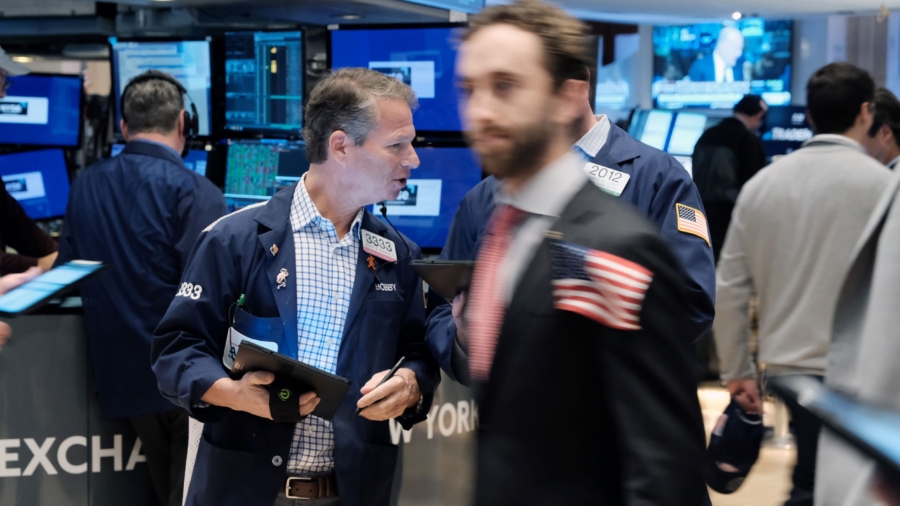U.S. stocks opened lower on Friday after Wall Street’s main indexes suffered their biggest decline in four weeks on Thursday, sparked by a hot inflation report and hawkish comments by Federal Reserve officials and investment bank bets on bigger interest rate hikes.
On Friday morning, shares slipped in Asia, Europe, and the United States, extending Thursday’s sharp declines on the major U.S. averages.
On opening bell Friday, the Dow Jones Industrial Average fell 19.84 points, or 0.06 percent, to 33,677.01. The S&P 500 opened lower by 13.02 points, or 0.32 percent, at 4,077.39, while the Nasdaq Composite dropped 78.33 points, or 0.66 percent, to 11,777.51 at the opening bell.
A day prior on closing bell, the Dow Jones Industrial Average dropped 431.20 points, or 1.26 percent, to end the session at 33,696.85. The benchmark S&P 500 dropped 1.38 percent to 4,090.41, while the tech-heavy Nasdaq Composite fell 1.78 percent to close at 11,855.83.
Hot Inflation Report Sinks Stocks
Thursday’s selloff in U.S. equities came after a government report showed producer price inflation (PPI), a leading indicator of consumer inflation, accelerating sharply.
Wholesale prices, which tend to get passed along to consumers down the road, jumped by 0.7 percent in January, showing that the prices of business inputs rose nearly twice as fast as analysts expected.
The bigger-than-expected jump in wholesale inflation put investors on edge, driving fears that the Federal Reserve would have to posture more aggressively to tame price pressures.
“With data like this, the Fed is going to keep raising rates, and none of us want that,” said Tim Ghriskey, senior portfolio strategist at Ingalls & Snyder in New York. “There are at least whispers now of the possibility of a 50 basis point hike at the next meeting.”
Other economic data supported the case for a more aggressive Fed. A Labor Department report showed that the number of Americans filing for unemployment benefits fell by more than analysts expected, providing fresh evidence that the labor market remains tight.
Bigger rate hike fears were amplified by remarks made by two senior Fed officials, who said they had advocated for larger 50-basis points interest rate increases at recent policy meetings, at which the rate-setting committee voted for smaller 25-basis point increases.
“I was an advocate for a 50-basis-point hike and I argued that we should get to the level of rates the committee viewed as sufficiently restrictive as soon as we could,” St. Louis Fed Bank President James Bullard told reporters at an event at the Greater Jackson Chamber in Jackson, Tennessee.
Bullard expressed hope that continued rate increases would “lock in” declines in consumer price inflation even as labor markets remain tight, putting upward pressure on wages and therefore prices.
Cleveland Fed Bank President Loretta Mester stated in a virtual speech to a Global Interdependence Center conference on Thursday that she saw a “compelling economic case” at the Fed’s meeting earlier this month to hike rates by double what it did.
At its latest meeting, the Fed’s rate-setting Committee voted to raise the overnight interest rate by a quarter point to a target range of 4.50 and 4.75 percent.
Investment bank Goldman Sachs said Thursday that it was expecting the Fed to raise interest rates three more times this year by a quarter point each time, up from a prior prediction for two rate increases.
Goldman now expects the Fed to take the fed funds rate to a peak of between 5.25 to 5.5 percent, roughly in line with market expectations.
‘Sufficiently Restrictive’
Mester said she expects to see a “meaningful improvement in inflation this year and further improvement over the following year,” with inflation slowing to the Fed’s 2 percent target in 2025. She cautioned, however, that this decline “is contingent on appropriate monetary policy.”
She added that she sees a need for policymakers to bring the Fed Funds rate “above 5 percent and hold it there for some time to be sufficiently restrictive to ensure that inflation is on a sustainable path back to 2 percent.”
While the White House cherry-picked data from the latest consumer price inflation (CPI) report to celebrate a slight reduction in inflation to 6.4 percent in year-over-year terms, Mester instead pointed to “a jump in the monthly rate of overall inflation and no improvement in underlying inflation.”
“The report provides a cautionary tale against concluding too soon that inflation is on a timely and sustained path back to 2 percent,” she said.
The CPI report showed month-over-month inflation accelerating sharply from 0.1 percent in December to 0.5 percent in January.
Bankrate chief financial analyst, Greg McBride, told The Epoch Times in an emailed statement that there were a few brighter spots in the CPI inflation report but overall it was far from satisfactory.
“The broad-based improvement needed to be seen in order to feel good about where inflation is headed is still lacking. The leading contributors continue to be categories that are staples of the household budget—food, shelter, electricity, natural gas, apparel, vehicle insurance, and household furnishing and operations,” he said.
Following the CPI inflation report, Richmond Fed President Thomas Barkin said in response to the data that the central bank may need to raise interest rates higher than previously expected if inflation continues to remain stubbornly elevated.
Barkin told Bloomberg that the inflation data was roughly in line with forecasts but added that he expects price pressures to keep percolating for longer.
“Inflation is normalizing but it’s coming down slowly,” he said. “I just think there’s going to be a lot more inertia, a lot more persistence to inflation.”
Reuters contributed to this report.
From The Epoch Times

